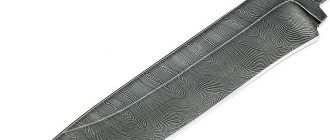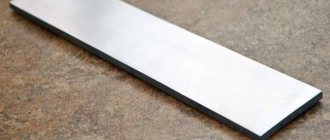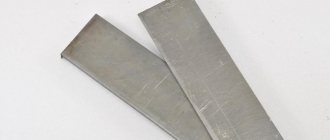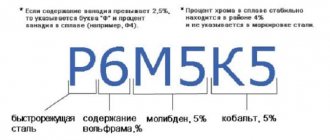The production of tourist knives is constantly being improved, and metallurgical plants are coming up with new alloys. They make the cost of the final product lower, and the quality of such knives is not inferior to imported analogues. In Russia, samples made of 95X18 stainless steel are widely used for knives, the pros and cons of which depend on the purposes of purchase and operation by each individual user.
Knife Beaver.
What kind of steel is this, identification of markings
Domestic grades of steel are usually classified according to GOST R54384 - 2011. According to it, to designate generally accepted grades of steel, alphanumeric terminology is adopted, indicating the content of carbon, alloying material and its content in the metal. Let's look at it using steel 95Х18 as an example:
- the number 95 represents the carbon content and is measured in fractions of a percent. Thus, its amount in the metal is 0.95%;
- the letter X indicates that the steel was alloyed with chromium;
- the number 18 shows the percentage of chromium in the finished material, that is, 18%.
For the production of what knives are used
The characteristics of the chemical composition and strength class allow blades made of this steel to hold an edge for a long time. The high chromium content provides products made from it with corrosion resistance. In addition, when exposed to moisture and acids, the metal does not tarnish and retains its natural shine for a long time.
Therefore, steel 95Х18 is used for the production of hunting, tourist, and also collectible knives.
Application
95Х18 was developed for the aviation and mechanical engineering industries, which needed an alternative to American steels 440C and 440B. Engineers and materials scientists were tasked with creating inexpensive steel that would have good hardness, wear resistance, and was slightly susceptible to corrosion.
As a result, domestic metallurgists created grade 95X18 steel, which is used in various industries for the manufacture of bearings, bushings, rods, rolled metal products, calibrated rods and other critical components and parts.
Chemical composition
The name of the metals that are used for alloying and their quantity must comply with GOST 5632 - 2014. The table below shows their content.
| steel grade | Alloying element | Mass fraction in metal, % | Purpose |
| 95Х18 | WITH | 0,9 – 1,0 | Used to impart hardness and strength to metal. |
| Cr | 17,0 – 19,0 | Used to improve the wear resistance and hardness of the alloy. In addition, it increases the metal's resistance to corrosion. | |
| Mn | 0,8 | The use of manganese improves the hardness of steel. | |
| Si | 0,8 | The introduction of silicon into the alloy composition improves the strength and abrasion resistance of steel, making it more reliable. | |
| Ni | 0,6 | The use of nickel can increase the metal's corrosion resistance and strength several times. | |
| Ti | 0,2 | The chemical properties of titanium make it possible to reduce the grain size of steel, thereby improving its heat resistance and ductility. | |
| P | no more than 0.03 | Phosphorus is a by-product of steel production. Therefore, they try to reduce its amount in the source material. | |
| S | no more than 0.025 | Sulfur is a harmful technological impurity. Its presence in the metal reduces toughness and strength. Therefore, a large amount of sulfur in high-quality steel is not allowed. |
Main indicators of the production process
Work in the metallurgical industry requires compliance with specified technological parameters and standardized techniques that comply with developed and approved GOSTs on Russian territory. The method of reforging or rolling the starting material has been successfully used to produce 95×18 steel. In this case, high temperature and slow cooling are important.
Characteristics
95Х18 is a high-alloy chromium steel of the martensitic class. It has a high carbon content, which gives it exceptional anti-corrosion properties.
The combination of elements used to alloy it made it possible to give the metal resistance to acids, as well as to the formation of scale.
Advantages and disadvantages
Like any material, 95X18 steel has its advantages and disadvantages. For greater clarity, they have been combined into the table below.
| Advantages | Flaws |
| Durability . Compliance with the technological process during hardening and tempering of the metal made it possible to endow the steel with high strength properties. | Impact strength . Due to the fact that the alloy contains impurities of phosphorus and sulfur, products made from such steel do not withstand impact loads well. |
| Hardness _ When smelting and hardening steel, it is given a hardness of 58 - 60 units on the Rockwell scale. | Sensitivity to compliance with the manufacturing process . During the smelting and processing of steel, full compliance with the rules and regulations of production and hardening is required. The slightest deviation leads to a change in the properties of the metal. |
| Wear resistance . The combination of alloying elements made it possible to achieve exceptional wear resistance. That is why 95X18 is used in the manufacture of bearings. | |
| Corrosion resistance . The presence of chromium and nickel in the composition increased the metal’s resistance to aggressive environments. | |
| Price . The use of a combination of inexpensive alloying components and the relative simplicity of the process of hardening and tempering of metal made it possible to reduce the cost of 95X18 in comparison with foreign analogues. | |
| Serviceability . High levels of hardness and strength allow knives made from this steel to hold an edge for a long time. In addition, the use of special devices is not required to make the blade sharp. | |
| Appearance . Products made from steel 95Х18 do not tarnish for a long time and have an attractive appearance. |
Production nuances
Steel 95X18 is quite difficult to produce due to imperfect equipment. To obtain a material with the required properties, it is subjected to:
- forging;
- roasting;
- hardening;
- vacation.
Raw materials are produced in accordance with GOST 5632-72 by smelting in an oxygen converter shop. After this, the metal is distributed through a continuous casting device, where it is poured into bloom, slab and billet forms. Most steel grades, including 95X18, are supplied in the form of a slab - a rectangular flat billet. Due to the fact that the output should be a fairly large semi-finished product, this grade of steel is rolled into coils in a hot rolling shop, where the metal is heated to 750–950 degrees before passing through the rolls. The output is a roll 1.2-12 mm thick. Most often, knives are made from billets, in particular, from rods obtained by drawing.
A roll or rod can be cut into pieces - sheets or smaller rods, which later serve as blanks for creating certain objects. An important stage in the production of a knife with the necessary characteristics is forging, which can be cold or hot, as well as machine or manual. For the industrial production of knives, a machine method is used, followed by cutting sheets or rods into fragments. The process takes place on hammers, deformation is carried out at a temperature of 900-1125 degrees, exactly when the crystal lattice is unstable. After forging, gradual cooling occurs to 750 degrees. It is important to know that stamping, used to create bearings and knives, is considered a separate type of forging.
After forging, hardening is carried out. The essence of this process is to impart special strength properties to the surface layer of the metal. The most important criteria are time and temperature. The workpiece is heated to values 30–50 degrees above the critical temperature, after which it is rapidly cooled in water or oil, less often in other substances, to a temperature of 450–650 degrees. At this stage, it is important not to cool the raw material too much, at the same time not allowing it to heat above 650 degrees. In the first case, softening of the metal may occur, and in the second, a significant increase in fragility.
The final stage is vacation. Tempering is carried out after the material has naturally cooled in air; this is necessary to get rid of internal stress and, accordingly, excessive fragility. The essence of the process is to heat the steel to 150–650 degrees, after which cooling occurs.
Another operation that is often used to produce knives is annealing. The purpose of this procedure is to increase the malleability of the metal to processing. To do this, the steel is heated to a certain temperature, held for some time and cooled naturally, after which another tempering is carried out. Annealing can be carried out both after receiving the castings, and at the very end - when the metal is processed by craftsmen. The workpiece can have different shapes:
- band;
- long products;
- rod.
All procedures are carried out in the forge. In fact, the share of manual labor in the manufacture of such products is quite large; it is still impossible to industrially achieve the creation of a high-quality hunting knife. However, fakes are still sold, although their quality is rather questionable. Only by applying all these steps can you obtain 95x18 steel with the required characteristics for a knife that will be used in difficult conditions.
Foreign analogues
Steel 95X18 is in great demand not only in the domestic but also in the foreign metal market. Despite this, it is not unique. Many foreign manufacturers produce steel with similar chemical and performance characteristics. The main analogues of steel 95Х18 can be considered:
- D2 . Steel developed in US steel mills has similar performance characteristics. Its average hardness on the Rockwell scale is 57 -61 units. The introduction of vanadium and molybdenum into the steel composition made it possible to improve the strength and toughness of the metal;
- 440C . Another steel grade developed in the USA. It has characteristics similar to domestic ones, but due to the higher phosphorus content it is more fragile;
- SUS440C . Japanese steel with characteristics similar to 440C.
Heat treatment conditions
According to GOST, martensitic, as it is marked by manufacturers, raw materials are continuously poured into blanks and rolled out in a hot converter shop at a temperature of 750-950°C.
The temperature conditions at different stages of processing are as follows:
- The maximum temperature for heating steel to a state of lattice instability is from 900 to 1125°C.
- The temperature when cooling the workpieces is up to 450-650°C.
- The temperature during tempering and returning the metal lattice structure to a stable state is 150-650°C.
The procedure for smelting steel 95Х18.
Comparison with analogues
Steel 95X18 has characteristics similar to its domestic and foreign counterparts. To make it easier to choose a specific metal, we compared them.
Which is better 95x18 or d2
Both grades of steel were developed for the manufacture of highly loaded parts operating under constant friction, so their performance indicators are very similar. The high content of carbon and chromium made it possible to use them for the manufacture of camping and tourist knives. Both steels hold an edge well, and the blade can be adjusted without using a special tool.
Application experience shows that 95X18 has better corrosion resistance and is less brittle than D2 steel. In addition, its cost is an order of magnitude lower, which is another undoubted advantage.
| Parameter | 95Х18 | D2 |
| Average hardness, units. H.R.C. | 58 – 60 | 57 – 61 |
| Chromium content, % | 18 | 12 |
| Carbon content, % | 0,9 – 1,0 | 1,5 |
| Maximum permissible phosphorus content, % | 0,03 | 0,04 |
| Maximum permissible sulfur content, % | 0,025 | 0,03 |
Comparison of 95x18 and x12MF - which is better
These steel grades were developed for the manufacture of machine parts in heavy engineering and have similar strength and wear resistance indicators. Their balanced characteristics were liked by domestic gunsmiths, who began to use them for the manufacture of hunting knives.
The high hardness of blades made of X12MF steel allows you to cut harder materials and stay sharp longer. However, they are very fragile, and correcting the sharpening in field conditions is problematic. The main difference between these steels is corrosion and acid resistance.
The high chromium content makes 95X18 more resistant to environmental influences, while the blade made of X12FM requires careful care.
| Parameter | 95Х18 | X12MF |
| Average hardness, units. H.R.C. | 58 – 60 | 62 – 64 |
| Chromium content, % | 18 | 11,75 |
| Carbon content, % | 0,9 – 1,0 | 1,55 |
| Maximum permissible phosphorus content, % | 0,03 | 0,03 |
| Maximum permissible sulfur content, % | 0,025 | 0,03 |
Price segment
Steel 95X18 is used by craftsmen to make camping and hunting knives in the mid-price segment. Due to its low cost, blades made from it are inexpensive. The price range ranges from 2500 – 3500 rubles per piece.
Knife "Jager" with a handle made of black hornbeam. Price 2875 rubles.
Knife “Sturgeon” with wenge handle. Price 3145 rubles.
Reviews from real owners
Since this steel has been used for making knives for quite a long time, there are many reviews about it on gunsmith forums. It should be noted that most of them are positive. Among them, we can highlight:
Personally, I have 2 of these knives in my arsenal. One is a hunting Husky, the other is a folding camping one. I go hunting regularly and use them all the time. For several years, the folding one has not yet worked, but the husky had to be sharpened once. I am very pleased with the purchase. I think that you can and should take knives from 95X18.
Previously, such steel was called medical. My father had many camp knives made from it. I, too, like him, am fond of hunting, and I don’t see an alternative. You can, of course, buy a knife made from foreign steel, but is it worth overpaying? The quality does not change, but the price increases noticeably.
Features of the production of steel 95x18
There are many types of steel, each of them has characteristic pros and cons. But when it comes to a specific product, not every steel is objectively suitable for its production (in our case, for knives). In order for the knife to serve for a long time while maintaining its original technical characteristics, it is recommended to use forged stainless steel 95x18, available in the form of rods of different diameters. To achieve a wedge-shaped shape, steel rods are forged into strips, which further increases their strength.
Set of kitchen knives made of steel








